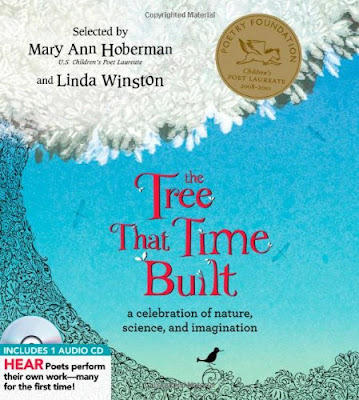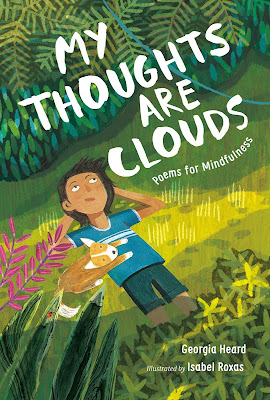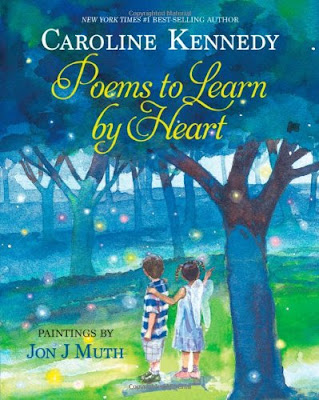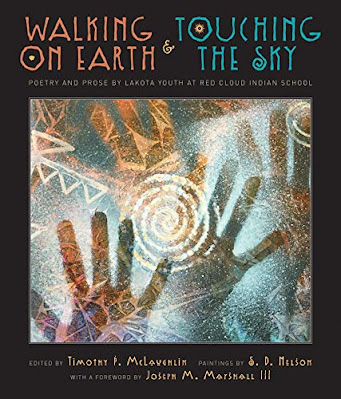The Tree That Time Built
Bibliography:
Hoberman, Mary Ann and Linda Winston. The Tree That Time Built: A Celebration of Nature, Science, and Imagination (A Poetry Speaks Experience). Ill. by Barbara Fortin. Naperville: Sourcebooks Jabberwocky, 2009. ISBN: 978-1402225178
Summary:
The Tree That Time Built is an ingenious interdisciplinary anthology of nature poetry united by the common thread of Darwin’s discoveries of evolutionary principles. Classic and contemporary poets (such as Mary Oliver, Emily Dickenson, Walt Whitman, Langston Hughes, Sylvia Plath, Hans Christian Anderson, Rumi, Joyce Sidman, Carl Sandberg, Eve Merriam, and Joseph Bruchac, to name a few) offer meditations on the remarkable adaptations of living organisms and celebrate the wonders of the natural world. Nine thematic sections divide the poems into topics with poetic headings such as “Oh, Fields of Wonder,” “The Sea is Our Mother,” “ Think Like a Tree,” “Some Primal Termite,” “Everything That Lives Wants to Fly,” “I Am the Family Face,” and “Hurt No Living Thing.” Each section begins with a prose introduction that expounds on the common themes and draws connections between beloved poems and the work of Charles Darwin. Footnotes provide scientific facts, word origins, historical context, and explanations of poetic devices. A glossary lists definitions of both scientific and poetic terms, appearing together in an intriguing and unique combination. A bibliography for further reading on Charles Darwin and evolutionary science is included, as well as a list of short biographical descriptions of the 77 poets included in this impressive collection. An audio CD features readings of 44 poems, many read by the authors themselves.
Analysis:
Children’s Poet Laureate (2008-2010) Mary Ann Hoberman and Linda Winston have crafted a profound and deeply interdisciplinary collection of poems that pay homage to the natural world and the rigorously curious point of view of the naturalist tradition. Drawing connections between poetic intuition and the scientific discoveries that confirm them, the poems and footnotes celebrate the scientific method and poetic insight. Ralph Waldo Emerson’s couplet “Atom from Atom,” written years before knowledge of atomic structure had been discovered, states, “Atom from atom yawns as far / As moon from earth, as star from star.” The editor’s footnote celebrates the poet’s intuition which was later confirmed through scientific discovery.
In the section of poems “Think Like A Tree,” the editors highlight the life-giving exchange of oxygen and carbon dioxide that occurs between plants and animals and invite readers to heed the wisdom of trees. In a concrete poem (or shape poem) by Karen I. Shragg, the readers are exhorted to “Think Like A Tree.” “Soak up the sun / Affirm life’s magic / Be graceful in the wind / Stand tall after a storm / Feel refreshed after it rains / Grow strong without notice / Be prepared for each season... “ David Wagoner similarly uses personification in his poem: “Stand still. The trees ahead and bushes beside you / Are not lost. Where you are is called Here, / And you must treat it as a powerful stranger, / Must ask permission to know it and be known.” The editors’ footnote emphasizes the reciprocity between humans and nature, comforting the reader with the truth that we are not lost; we’re here.
In a haiku by Hoberman herself, she captures the “Metamorphosis” of a butterfly in just three lines: “Metamorphosis: / Caterpillar, chrysalis, / Butterfly is born.” The range of poetic styles paired with scientific knowledge and historical background makes this collection a treasury of teachable moments for students of both poetry and science. Greek and Latin word origins are illuminated, anecdotes from Darwin’s research are shared, including a found poem piecing together phrases from Darwin’s notebooks and even a poem by Darwin’s great-great-granddaughter! For such a scholarly anthology, it is surprisingly accessible, including short poems with many appealing rhymes that are pleasing to read aloud such as Douglas Florian’s “The Chameleon.” “Although it may seem very strange, The colors on a chameleon change / From mousy browns to leafy greens / And several colors in between.” Barbara Fortin’s grayscale illustrations embellish the poems with leaves, insects, shells, trees and microorganisms, adding attractive visual interest throughout the pages.
This anthology is an ideal bridge between science and language arts. Highly recommended for readers ages 7 and up. Some poems may be more challenging than others, but there is something for everyone and many layers to discover. Perfect for introductions to natural science lessons on numerous topics.
Excerpt:
“Something Told the Wild Geese”
by Rachel Field
Something told the wild geese
It was time to go.
Though the fields lay golden
Something whispered, --”Snow.”
Leaves were green and stirring,
Berries, luster-glossed,
But beneath warm feathers
Something cautioned, --”Frost.”
All the sagging orchards
Steamed with amber spice,
But each wild breast stiffened
At remembered ice.
Something told the wild geese
It was time to fly, --
Summer sun was on their wings,
Winter in their cry.
Footnote: “Animal migration is one of nature’s mysteries. How do wild geese know precisely when to migrate and how do they return to the same winter habitat year after year? In the spring how do they find their way home? It is known that they use both the stars and the sun as navigational aids; in addition the winds and the earth’s magnetic fields may help them. Flying at speeds as high as sixty miles per hour, often covering distances of three thousand miles in a single migratory season, wild geese are among nature’s marvels.”
Activities:
- Share Rachel Field’s poem “Something Told the Wild Geese” as an introduction to a lesson on animal instinct and migration. Read the footnote and the poem together for a succinct and memorable demonstration. Pair with photos of geese and maps charting their migratory routes.
- Utilize the resources included in the book for further study and research on Charles Darwin and evolutionary principles.




Comments
Post a Comment